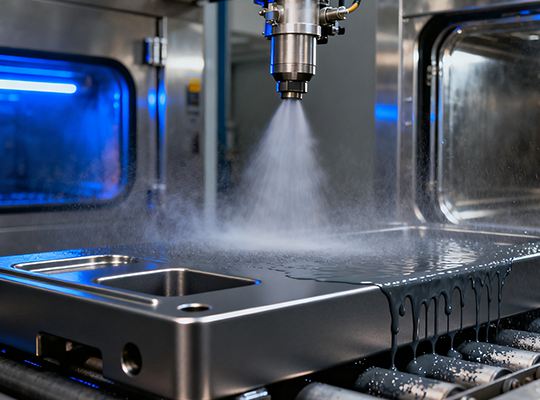Enter keywords
Online

Professional Metal Enclosure Manufacturer:
Metal Assembly and System Solution
Custom CNC Machining Service:
System Solution
Product Inquiry
All Product Categories
Machined sensor housing
Machining Cases
Machined sensor housing
Machined parts are usually made of solid blocks of material and have excellent strength and stability. They can meet the needs of various applications and can produce high-precision, high-surface quality parts to meet the strict precision requirements of precision instruments, optical equipment, aerospace and other fields. They can process parts with complex shapes to adapt to specific design requirements. Machined parts are widely used in mechanical manufacturing, electronic appliances, medical equipment, mold manufacturing and other fields, and are an indispensable part of modern industry.
Contact Us
Catalog
Related Products
Design Drawings
You can upload 2D or 3D design drawings, and we will respond in 2-8 hours!

Aluminum
Copper
Bronze
Steel Plate
Stainless Steel
Magnesium
Titanium
Tool Steel
Alloy Steel
Materials
Surface Treatment
Molding
CNC machining centers are advanced CNC mills with automatic tool changers (ATC), capable of complex operations in one setup.

(01)
3-Axis CNC
A common high-precision CNC milling machine with three axes (X, Y, Z) for efficient 2D and 3D machining.
Processing
Basic processes: milling, drilling, tapping, chamfering, slotting; suitable for high-precision parts and mass production.
Workpieces
Installation plates, mold baseplates, aluminum parts, electronic housings, etc.
Advantages
Stable performance, cost-effective; easy programming and debugging; suitable for most standard parts.


(02)
4-Axis CNC
A 4-axis CNC adds a rotary axis (usually A-axis) to enable multi-face machining, improving precision and efficiency.
Processing
Can perform all 3-axis operations and multi-face machining; ideal for complex parts requiring drilling, tapping, and slotting.
Workpieces
Aluminum housings, flanges, connection parts, fixture bases, precision mounts, etc.
Advantages
Multi-face machining enhances efficiency and consistency; reduces errors and improves overall precision.

(03)
CNC Lathe
CNC lathes are used for high-precision turning of cylindrical parts, with automated tool movement in X and Z axes.
Processing
Operations: outer diameter turning, end face machining, boring, taper turning, threading; suitable for mass production of shafts, rings, and sleeves.
Workpieces
Hydraulic shafts, drive shafts, flanges, threaded parts, copper bushings, stainless steel parts, etc.
Advantages
Fast processing speed, high stability and precision; high automation, saving labor.

FAQs
What are the advantages of five-axis CNC machining over three-axis? Do you offer five-axis machining services?
The main advantages of five-axis machining are: 1. It allows for the machining of complex polyhedrons in a single setup, improving precision and efficiency; 2. It enables machining areas that three-axis machining cannot reach (such as deep cavities and curved surfaces at unusual angles); and 3. It reduces the need for fixtures. We offer five-axis CNC milling services, specializing in precision parts for aerospace, medical devices, and complex molds.
Can complex parts be machined?
Yes, CNC multi-axis machining excels at processing complex geometries and precision parts.
Can you do proofing or small batch processing?
We are very welcome to provide you with quick response.
How to ensure tool life and machining accuracy when machining carbide or hardened steel (hardness above HRC50)?
Machining high-hardness materials requires specialized strategies: using high-performance carbide or CBN/PCD tools; optimizing cutting parameters (low speed, high feed, and shallow depth of cut); ensuring equipment rigidity and stability; and employing high-pressure coolant for efficient chip removal. Our extensive experience in machining high-hardness materials and specialized equipment ensure effective tool wear control, ensuring machining accuracy and surface quality.
How to ensure quality stability and consistency for large-volume machining orders?
We ensure consistent quality during mass production through the following measures: 1. Comprehensive first-article inspection and confirmation; 2. Standardized processing procedures and process cards; 3. Regular spot checks (dimensional and appearance) during production; 4. Automated testing equipment; and 5. A comprehensive equipment maintenance system to ensure machine tool accuracy. SPC process control can be implemented upon request.
Can you provide one-stop machining services including post-processing (such as heat treatment and surface finishing)?
Yes, we offer a one-stop solution from raw material to finished product. In addition to core machining processes (turning, milling, wire EDM, etc.), we also assist in arranging or directly provide supporting services, including heat treatment (quenching, tempering, carburizing, etc.), grinding (surface grinding, cylindrical grinding), and various surface treatments (sandblasting, polishing, oxidation, electroplating, spraying, etc.), streamlining your supply chain management.
Contact us
You can contact us through the following four methods, and we will respond to your inquiry promptly!
1. Call us
2. Send an email
3. Message form
4. Add WeChat or Whatsapp

Upload drawings for quotes.
Your documents are safe.
Upload drawing
Confirm order
Parts arrival
































